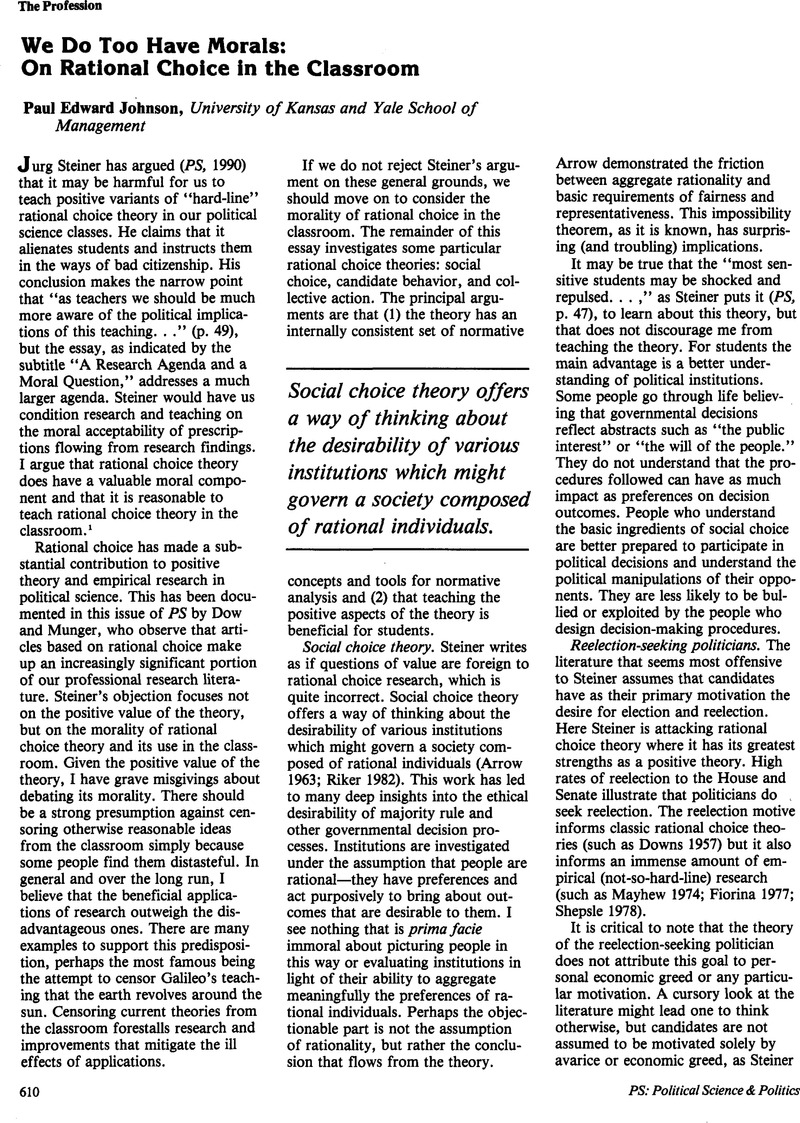No CrossRef data available.
Article contents
We Do Too Have Morals: On Rational Choice in the Classroom
Published online by Cambridge University Press: 02 September 2013
Abstract
An abstract is not available for this content so a preview has been provided. As you have access to this content, a full PDF is available via the ‘Save PDF’ action button.

- Type
- News
- Information
- Copyright
- Copyright © The American Political Science Association 1990
References
Alesina, Alberto. 1988. “Credibility and Policy Convergence in a Two-Party System with Rational Voters.” American Economic Review
78: 796–805.Google Scholar
Arrow, Kenneth. 1963. Social Choice and Individual Values, 2nd ed.
New Haven: Yale University Press.Google Scholar
Austen-Smith, David and Banks, Jeffrey. 1988. “Elections, Coalitions, and Legislative Outcomes.” American Political Science Review
82: 405–22.CrossRefGoogle Scholar
Buchanan, James M. and Tullock, Gordon. 1962. The Calculus of Consent: Logical Foundations of Constitutional Democracy. Ann Arbor: University of Michigan Press.Google Scholar
Calvert, Randall. 1985. “Robustness of the Multidimensional Voting Model: Candidate Motivations, Uncertainty, and Convergence.” American Journal of Political Science
39: 69–95.CrossRefGoogle Scholar
Denzau, Arthur T. and Munger, Michael C.
1986. “Legislators and Interest Groups: How Unorganized Interests Get Represented.” American Political Science Review
80: 89–106.CrossRefGoogle Scholar
Dow, Jay and Munger, Michael C.
1990. “Political Science and Politics: We Publish It But We Don't Teach It.” PS: Political Science & Politics, 23, 604–609.Google Scholar
Fenno, Richard F. Jr., 1978. Home Style: House Members in Their Districts. Boston: Little, Brown.Google Scholar
Fiorina, Morris. 1977. Congress: Keystone of the Washington Establishment. New Haven: Yale University Press.Google Scholar
Mayhew, David R.
1974. Congress: The Electoral Connection. New Haven: Yale University Press.Google Scholar
Mueller, Dennis C.
1989. Public Choice II: A Revised Edition of Public Choice. Cambridge: Cambridge University Press.Google Scholar
Olson, Mancur Jr., 1971. The Logic of Collective Action. Cambridge, MA: Harvard University Press.Google Scholar
Parker, Glenn R.
1989. “Looking Beyond Reelection: Revising Assumptions about the Factors Motivating Congressional Behavior.” Public Choice
63: 237–252.CrossRefGoogle Scholar
Riker, William H.
1982. Liberalism Against Populism: A Confrontation between the Theory of Democracy and the Theory of Social Choice. San Francisco: W.H. Freeman.Google Scholar
Shepsle, Kenneth A.
1978. The Giant Jigsaw Puzzle: Democratic Committee Assignments in the Modern House. Chicago: University of Chicago Press.Google Scholar
Shepsle, Kenneth A. and Weingast, Barry. 1984. “Political Solutions to Market Problems.” American Political Science Review
78: 417–434.CrossRefGoogle Scholar
Steiner, Jurg. 1990. “Rational Choice Theories and Politics: A Research Agenda and a Moral Question.” PS: Political Science & Politics
23: 46–50.Google Scholar
Tullock, Gordon. 1984. “A (Partial) Rehabilitation of the Public Interest Theory.” Public Choice
42: 89–99.CrossRefGoogle Scholar
Walker, Jack L.
1990. “Political Mobilization in America,” in Institutions in American Society: Essays in Market, Political, and Social Organizations, ed. Jackson, John E.. Ann Arbor: University of Michigan Press, pp. 163–188.Google Scholar
Wittman, Donald. 1983. “Candidate Motivation: A Synthesis of Alternatives.” American Political Science Review
77: 142–57.CrossRefGoogle Scholar


